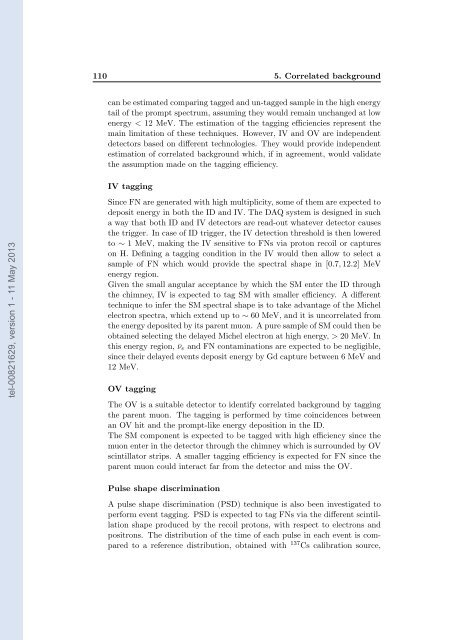Etude et impact du bruit de fond corrélé pour la mesure de l'angle ...
Etude et impact du bruit de fond corrélé pour la mesure de l'angle ...
Etude et impact du bruit de fond corrélé pour la mesure de l'angle ...
Create successful ePaper yourself
Turn your PDF publications into a flip-book with our unique Google optimized e-Paper software.
110 5. Corre<strong>la</strong>ted background<br />
can be estimated comparing tagged and un-tagged sample in the high energy<br />
tail of the prompt spectrum, assuming they would remain unchanged at low<br />
energy < 12 MeV. The estimation of the tagging e ciencies represent the<br />
main limitation of these techniques. However, IV and OV are in<strong>de</strong>pen<strong>de</strong>nt<br />
d<strong>et</strong>ectors based on di↵erent technologies. They would provi<strong>de</strong> in<strong>de</strong>pen<strong>de</strong>nt<br />
estimation of corre<strong>la</strong>ted background which, if in agreement, would validate<br />
the assumption ma<strong>de</strong> on the tagging e ciency.<br />
IV tagging<br />
tel-00821629, version 1 - 11 May 2013<br />
Since FN are generated with high multiplicity, some of them are expected to<br />
<strong>de</strong>posit energy in both the ID and IV. The DAQ system is <strong>de</strong>signed in such<br />
a way that both ID and IV d<strong>et</strong>ectors are read-out whatever d<strong>et</strong>ector causes<br />
the trigger. In case of ID trigger, the IV d<strong>et</strong>ection threshold is then lowered<br />
to ⇠ 1 MeV, making the IV sensitive to FNs via proton recoil or captures<br />
on H. Defining a tagging condition in the IV would then allow to select a<br />
sample of FN which would provi<strong>de</strong> the spectral shape in [0.7, 12.2] MeV<br />
energy region.<br />
Given the small angu<strong>la</strong>r acceptance by which the SM enter the ID through<br />
the chimney, IV is expected to tag SM with smaller e ciency. A di↵erent<br />
technique to infer the SM spectral shape is to take advantage of the Michel<br />
electron spectra, which extend up to ⇠ 60 MeV, and it is uncorre<strong>la</strong>ted from<br />
the energy <strong>de</strong>posited by its parent muon. A pure sample of SM could then be<br />
obtained selecting the <strong>de</strong><strong>la</strong>yed Michel electron at high energy, > 20 MeV. In<br />
this energy region, ¯⌫ e and FN contaminations are expected to be negligible,<br />
since their <strong>de</strong><strong>la</strong>yed events <strong>de</strong>posit energy by Gd capture b<strong>et</strong>ween 6 MeV and<br />
12 MeV.<br />
OV tagging<br />
The OV is a suitable d<strong>et</strong>ector to i<strong>de</strong>ntify corre<strong>la</strong>ted background by tagging<br />
the parent muon. The tagging is performed by time coinci<strong>de</strong>nces b<strong>et</strong>ween<br />
an OV hit and the prompt-like energy <strong>de</strong>position in the ID.<br />
The SM component is expected to be tagged with high e ciency since the<br />
muon enter in the d<strong>et</strong>ector through the chimney which is surroun<strong>de</strong>d by OV<br />
scintil<strong>la</strong>tor strips. A smaller tagging e ciency is expected for FN since the<br />
parent muon could interact far from the d<strong>et</strong>ector and miss the OV.<br />
Pulse shape discrimination<br />
A pulse shape discrimination (PSD) technique is also been investigated to<br />
perform event tagging. PSD is expected to tag FNs via the di↵erent scintil<strong>la</strong>tion<br />
shape pro<strong>du</strong>ced by the recoil protons, with respect to electrons and<br />
positrons. The distribution of the time of each pulse in each event is compared<br />
to a reference distribution, obtained with 137 Cs calibration source,





![[tel-00726959, v1] Caractériser le milieu interstellaire ... - HAL - INRIA](https://img.yumpu.com/50564350/1/184x260/tel-00726959-v1-caractacriser-le-milieu-interstellaire-hal-inria.jpg?quality=85)










